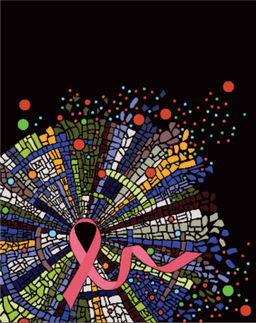Immune cells in the liver drive fatty liver disease and liver cancer
immune cells that migrate to the liver and interact there with liver tissue cells get activated by metabolic stress (e.g. through lipids of a high fat diet) and drive the development of fatty liver disease, non-alcoholic steatohepatitis and liver cancer. Scientists from the Helmholtz Zentrum München made this discovery and thus identified the previously unknown mechanism underlying these serious and widespread diseases. The results of their research have been published as the cover story of the renowned medical journal cancer Cell.
Fatty liver disease – alongside fatty liver due to massive alcohol consumption – is mainly caused by excessive consumption of fat and sugar combined with a lack of exercise or a sedentary life style. This is referred to as non-alcoholic fatty liver disease (NAFLD). If NAFLD becomes chronic – e.g. through the constant uptake of high lipids and high sugar combined with lack of excercise a chronic inflammatory response is triggered in the liver tissue in addition. This can lead to non-alcoholic steatohepatitis (NASH) – a liver disease with clear detectable pathologic alteratons of the tissue. These liver diseases (NAFLD and NASH), along with chronic viral infections, are the most common causes of liver cancer, or hepatocellular carcinoma (HCC). In the United States, about 90 million people suffer from NAFLD. In Europe, the figure is more than 40 million, and even in threshold countries like India and China, the number of people affected is rising due to increasingly unhealthy lifestyles. More worrying, in all of the above mentioned states the numbers of NAFLD and NASH patients is constantly increasing. Consequently, the incidence of HCC resulting from NASH and NAFLD is also rising worldwide. In the United States, HCC is the fastest-growing form of cancer at the moment. No efficient causal therapy exists for HCC patients of which appr. 800.000 die every year.
T cells involved in the development of fatty liver disease, NASH and HCC
The mechanisms that cause diseases such as fatty liver disease, steatohepatitis and HCC are still not widely understood. However, immune cells, particularly CD8+ T cells and NK T cells seem to play an important role. This finding was made by a team of scientists led by Prof. Mathias Heikenwälder, Prof. Matthias Tschöp, Dr. Kerstin Stemmer, Dr. Kristian Unger, Prof. Ulrike Protzer and the working group of Dr. Hans Zischka from the Helmholtz Zentrum München together with a team headed by Prof. Percy Knolle of the Technische Universität München (TUM), Prof. Achim Weber from Zurich University Hospital and Dr. Monika Wolf, Institute of Surgical Pathology, University Hospital Zurich. The animal model which was used to examine the long-term effects of metabolic syndrome enabled the scientists to elucidate new mechanisms that cause fatty liver disease and also show how it can develop into liver cancer.
Inflammatory events offer starting point for prevention and treatment
The scientists assume that an existing metabolic imbalance results in the activation and migration of immune cells to the liver. There, the immune cells interact with liver cells and trigger an inflammatory response that damages the liver tissue and also destabilizes the metabolic activity of the liver cells. “Initially it immune cells promote fatty liver degeneration. The inflammation, which is triggered by specific immune cells, encourages the progression of fatty liver pathology and causes NASH to develop. These processes are the basis for liver cell degeneration, which can cause HCC,” explains Prof. Heikenwälder, who led the study. “Our results provide completely new insights into the development of these serious liver diseases. Building on this knowledge, we now want to develop new, preventive and therapeutic strategies to combat these diseases.” The initial studies are already under way in the preclinical model.
Original publication
Other news from the department science

Get the life science industry in your inbox
From now on, don't miss a thing: Our newsletter for biotechnology, pharma and life sciences brings you up to date every Tuesday and Thursday. The latest industry news, product highlights and innovations - compact and easy to understand in your inbox. Researched by us so you don't have to.
























































